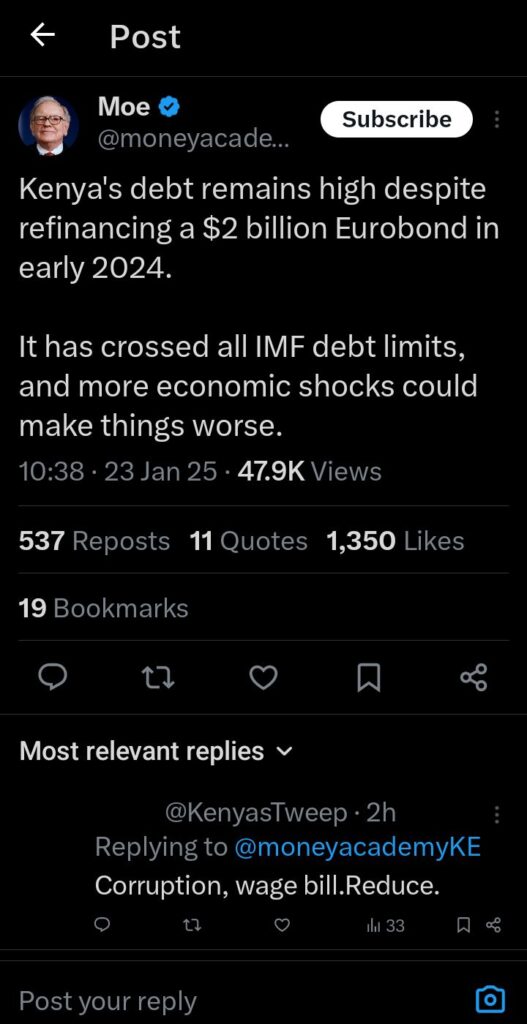Kenya’s financial situation remains precarious, and this was brought to light by MOE through his X Space.
He revealed that despite refinancing a $2 billion Eurobond in early 2024, the country’s public debt has surpassed all International Monetary Fund (IMF) debt limits.
This paints a grim picture of a nation at significant risk of debt distress.
The possibility of further economic shocks only adds to the fragility of Kenya’s financial stability.
Kenya attempted to manage its debt by issuing a new $1.5 billion Eurobond to refinance the maturing $2 billion Eurobond.
However, MOE noted that this move has not improved the debt situation.
The Parliamentary Budget Office (PBO) has highlighted how key debt sustainability indicators, such as the debt service-to-revenue ratio and the debt-to-gross domestic product (GDP) ratio, are worsening.
This is largely attributed to declining revenue collections and rising costs of debt repayment.

Kenya’s public debt ballooned by Ksh1.93 trillion ($13.3 billion), reaching Ksh11.14 trillion ($76.6 billion) in 2023, up from Ksh9.2 trillion ($63.2 billion) in 2022.
MOE emphasized that a staggering 58.8% of government revenues are now being used to service debt, leaving only 41.2% for critical development programs.
The debt-to-GDP ratio has climbed from 65.8% in the 2019/2020 fiscal year to 71.8% by June 2023, further indicating an unsustainable debt trajectory.
In an effort to address the mounting debt, Kenya replaced its numerical debt ceiling with a limit set at 55% of GDP in present value terms.
The rapid depreciation of the Kenyan shilling standing at KSh147.8 against the US dollar in September 2023, marking a 22% drop in one year has exacerbated inflation and made debt servicing even more expensive.
MOE also pointed out that the government’s efforts to raise more revenue through higher taxes have fallen short of expectations.
Combined with a lack of reductions in government spending, this has fueled widespread public discontent.
By mid-2024, the nation was rocked by demonstrations against austerity measures introduced under a finance bill.
These measures, dictated by conditions from the IMF’s 2021 loan agreement, included increased taxes and reduced subsidies.
MOE revealed that citizens felt these policies benefited foreign investors at the expense of local needs, leading to violent protests and loss of lives.
Kenya’s relationship with the IMF has remained a contentious issue.
While the IMF argues that its loans are designed to prevent default and ensure long-term sustainability, MOE criticized the institution for imposing fiscal policies that worsen inequality and fail to address the immediate needs of Kenyans.
The ongoing unrest reflects a growing dissatisfaction with external financial controls and calls for economic strategies tailored to the country’s unique challenges.
Global economic conditions have only added to Kenya’s financial woes. High global interest rates and dwindling international confidence in Kenyan government bonds have made borrowing costlier.
However, this plan was abandoned after Moody’s Investors Services warned that repurchasing the bonds below par value would amount to a loss for investors.
Kenya’s debt crisis remains dire, despite efforts to manage it through refinancing and policy shifts.
As the country deals with high debt levels, declining revenues, and looming economic shocks, it must prioritize policies that protect its citizens and reduce dependence on external financial interventions.


